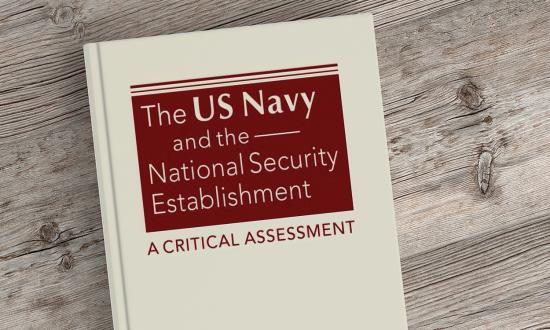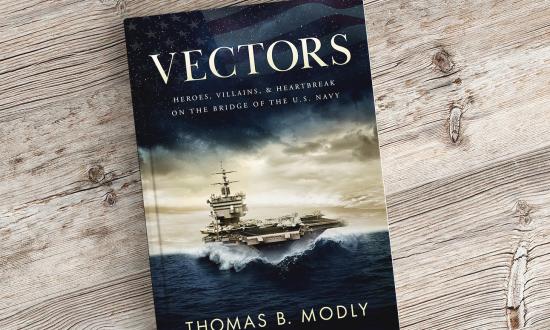Subversion: The Strategic Weaponization of Narratives
Andreas Kreig. Washington, DC: Georgetown University Press, 2023. 241 pp. Sources. Biblio. Index. $34.95.
Reviewed by Commander Chris O’Connor, U.S. Navy
Are you familiar with the terms “weaponized narratives?” or “sociopsychology?” If so, reading this book will not be as steep a learning curve as it was for this reviewer. Subversion begins with an introduction on competition below the threshold of war using these terms and does not let up until the end. Though a well-researched examination of the topic, its weaknesses lie in its chapter order and its shortage of case studies.
An interesting read about nations using the tactic of subversion to wage war in the cognitive and information spaces, the book opens the discussion in media res and only later explains the thesis. An early chapter pulls the reader in with an absorbing discussion about the “Sociopsychology of Truth.” Starting back in history predating Plato’s “The Allegory of the Cave,” it draws a thread through that to weaponized narratives shaping what is perceived as “truth” in modern societies. The book then hits its stride, examining the methods that authoritarians use to control narratives by means of modern advances in computing and networks, while also employing think tanks and business ties to influence other nations’ decision-makers directly.
The case study chapters are of differing strength. The first, on Russia’s methods, is a well-worn path in security scholarship, including well-publicized election interference operations in the United States. Written at the beginning of the 2022 invasion of Ukraine, this part of the book is now dated because of recent events that prove that Russia has weaknesses in this realm.
The more enlightening case study is the second one, which examines how the United Arab Emirates (UAE) became one of the most influential countries in the Middle East by cultivating the “Little Sparta” image through extensive influence networks. It shows how the UAE responded with information warfare methods to its fears of growing instability after the 2011 Arab Spring. This is a more important discussion because it depicts how a small power can gain global clout in the information domain and target its allies and partners—including the United States—while still maintaining close relationships in other domains.
Subversion would be an even better book if it contained more case studies to bolster the author’s ideas on the stages of subversion operations and the means by which they are carried out. China’s narratives on the Uighurs or other contentious matters would be topical, and even better would be an examination of other U.S. allies and partners and how they influence our nation.
The penultimate and concluding chapters are a welcome tonic after reading how the United States has been influenced in the past. They outline how democracies can develop information resilience in the face of information warfare methods, no matter how difficult attaining this goal would be.
Weaponized narratives can change how we perceive the world and affect the very function of our decision-making process. If you need an understanding of subversion as an international security practitioner, this book will help get you there.
Commander O’Connor is a strategic plans officer at NATO Supreme Headquarters Allied Powers Europe (SHAPE) and is the vice president of CIMSEC.
The New Age of Naval Power in the Indo-Pacific: Strategy, Order, and Regional Security
Catherine L. Grant, Alessio Patalano, and James A. Russell, Eds. Washington, D.C.: Georgetown University Press, 2023. 340 pp, $45.95
Reviewed by Commander Ryan Hilger, U.S. Navy
The Indo-Pacific is arguably the defining theater of the current century. Thirty-eight nations and more than 50 percent of the world’s population speaking more than 3,000 different languages call the region home. A significant proportion of the world’s economy passes through the region, calling at nine of the world’s ten largest ports. China and the United States dominate the regional security picture, with many countries in the western Pacific playing pivotal or
influential roles in shaping it, including five nuclear-armed nations. The region’s history is replete with great power rivalry, and the effects of previous rivalries reverberate today. The region is decidedly complex, and scholars and practitioners can spend entire careers trying to understand the dynamics.
U.S. military officers and enlisted personnel make up the majority of the U.S. contact layer with the region, making their actions crucial in shaping the region’s impression of the United States on a daily basis. Success demands that these personnel have a solid understanding of the fundamental issues and history of the region, and The New Age of Naval Power in the Indo-Pacific seeks to assist in that Herculean task.
Catherine Grant, Alessio Patalano, and James Russell have brought many of the leading scholars of the region to provide accessible information for practitioners and an original framework highlighting the factors of influence in the region and why naval power is so crucial in the region. The framework draws on naval power and how states use it to exert control over sea lines of communication, deploy nuclear deterrents at sea, implement and enforce the law of the sea in advantageous ways, control marine resources, and provide capacity for technical innovation. These five factors are grounded in the history of the region from the early imperial periods through the Cold War to today, and still influence how the nations behave and strive for regional or global influence.
Each area of the Indo-Pacific brings unique challenges based on the countries in the area and their history. How the United States should act strategically down to the contact layer changes when discussing the Korean Peninsula or the Indian Ocean or the Taiwan Strait. The security issues are fluid as regional blocks of power, ranging from the Association of Southeast Asian Nations to AUKUS to the Quad, shift in response to the actions of other nations, in particular, of China.
Military members will find The New Age of Naval Power in the Indo-Pacific to be a readily accessible guidebook, giving them a deeper understanding of the dynamics and complexity of the region. It should be kept in the wardrooms of U.S. ships and squadrons and added to the Chief of Naval Operations’ required reading list. Amid calls for greater strategic education of the naval officer corps for great power competition, The New Age of Naval Power in the Indo-Pacific provides a ready companion to educate the next generation of personnel in the coming years, and I strongly recommend it.
Commander Ryan Hilger is an engineering duty officer stationed in Cape Canaveral, Florida.
China’s New Navy: The Evolution of PLAN from the People’s Revolution to a 21st Century Cold War
Xiaobing Li. Annapolis, MD: Naval Institute Press, 2023. 285 pp. Notes. Biblio. Index. $30.
Reviewed by Lieutenant Commander Shane Halton, U.S. Navy
In the mid-1990s, China barely registered as a maritime power, with a small navy relative to its population and economic heft, focused mostly on coastal defense. Today, it has the largest navy in the world and regularly sends ships into the central Pacific and across the Indian Ocean. China’s navy is buttressed by an increasingly professional and well-equipped coast guard and operates within a modern joint theater construct analogous to the U.S. military’s combatant command model.
As formidable as the People’s Liberation Army Navy (PLAN) appears on paper, analysts have raised several as-of-yet-unanswered questions about its capabilities and operational prowess. How well are the PLA’s different services, including the PLAN, integrated within the new joint structure? Is the PLAN underinvesting in its noncommissioned officer (NCO) corps to its long-term detriment? Do the PLAN’s captains have the freedom to respond dynamically to events on the water or is their every action micromanaged by superiors in the operational chain of command? And how is a navy with almost no recent combat experience training for high-end conflict?
Xiaobing Li’s China’s New Navy, unfortunately, does not grapple with any of the above questions. Instead, it opts for a linear history of the PLAN, starting in the late 1940s at the end of the Chinese Civil War and ending in 2017. Each of the six chapters covers approximately a decade. This is not entirely a bad thing; Li conducted many interviews with former PLAN and Taiwanese naval officers and officials to provide well-rounded and engaging accounts of some pivotal moments in Chinese naval history, notably the first (1954) and third (1995) Taiwan Strait crises and the 2001 Hainan Island incident. The book would have been more accurately titled A History of the PLAN: 1949–2017.
The final two chapters—covering roughly 2000 to 2017—suffer from some factual errors. Li states that Hu Jintao replaced Jiang Zemin as Party Chairman in 2012 (it was 2002), that the Chinese purchased Su-30s and Su-34 fighters from Russia (Su-27s not Su-34s), and that the Luyang destroyer’s HQ-9 is equivalent to a U.S. Patriot system (the more accurate analogy is the U.S. Navy’s Standard Missile family of systems). These errors are distracting and mar what should be the strongest part of the book.
Lieutenant Commander Halton is an intelligence officer currently serving on the USS Carl Vinson (CVN-70). He has previously served on exchange with the Royal Australian Navy and as a requirements officer at the Navy’s Digital Warfare Office.









